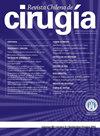Seis años de experiencia en cirugía digestiva asistida por robot
Q4 Medicine
引用次数: 0
Abstract
Background: Since its approval, robotic surgery has been growing as a useful, promising and probably superior technique for many surgeries. The aim of this study is to expose and evaluate the results of a 6-year experience, of a single surgeon, with robotic assisted surgery, used for different gastrointestinal procedures throughout this years. Study Design: We conducted a retrospective revision of all consecutive robotic assisted gastrointestinal cases performed by a single gastrointestinal laparoscopic surgeon of the Bariatric Surgery Department and Robotics Surgery Department of Clinica Santa Maria of Santiago, Chile, between September 2011 and May 2017. Results: A total of 290 patients underwent robotic gastrointestinal surgery during 6 years. All cases were performed by the same gastrointestinal surgeon. Primary procedures performed were totally hand sewn Roux-en-Y gastric bypass, sleeve gastrectomy, revisional bariatric and non-bariatric surgery, Nissen fundoplication, single port cholecystectomy, Heller myotomy with Dor fundoplication, hernia repairs, and other exceptional cases. A total of 512 procedures were performed in 290 patients. The majority of secondary procedures were cholecystectomies, hiatal hernia repairs and adhesiolysis. Average length of hospital stay was 3 days. Postoperative complications were observed in 27 (9.3%) patients. According to Clavien Dindo classification of surgical complications, 4 (1.4%) complications were Clavien I, 5 (1.7%) Clavien II, 18 (6.2%) Clavien III, 0 Clavien IV, 0 Clavien V. There were no deaths in this group. Mean operative time was 76 minutes. Mean surgical time was 64 minutes. Conclusion: Robot assisted upper gastrointestinal surgery is a reliable and effective technique, that can be used in many diseases.6年机器人辅助消化手术经验
背景:自从机器人手术被批准以来,它已经成为一种有用的、有前途的、可能是许多手术的优越技术。本研究的目的是揭露和评估一名外科医生6年来在机器人辅助下进行不同胃肠手术的结果。研究设计:我们对2011年9月至2017年5月期间由智利圣地亚哥圣玛丽亚临床医院减肥外科和机器人外科的一名胃肠腹腔镜外科医生连续进行的所有机器人辅助胃肠道病例进行了回顾性修订。结果:6年间共有290例患者接受了机器人胃肠手术。所有病例均由同一位胃肠外科医生进行手术。主要手术包括全手缝Roux-en-Y胃旁路术、袖胃切除术、减肥和非减肥手术、Nissen底折叠术、单端口胆囊切除术、Heller肌切开术合并Dor底折叠术、疝修补术和其他特殊病例。290例患者共进行了512次手术。次要手术主要是胆囊切除术、裂孔疝修补术和粘连松解术。平均住院时间为3天。术后出现并发症27例(9.3%)。根据手术并发症Clavien Dindo分类,Clavien I型4例(1.4%),Clavien II型5例(1.7%),Clavien III型18例(6.2%),Clavien IV型0例,Clavien v型0例(6.2%),本组无死亡病例。平均手术时间76分钟。平均手术时间为64分钟。结论:机器人辅助上消化道手术是一种可靠、有效的手术技术,可用于多种疾病。
本文章由计算机程序翻译,如有差异,请以英文原文为准。
求助全文
约1分钟内获得全文
求助全文
来源期刊

Revista Chilena De Cirugia
Medicine-Surgery
CiteScore
0.20
自引率
0.00%
发文量
0
审稿时长
6-12 weeks
期刊介绍:
La Revista Chilena de Cirugía es un órgano de difusión del conocimiento y actividad quirúrgica. Su población objetivo son cirujanos, especialistas de otras áreas médicas, médicos generales y alumnos del área de la salud.
Sirve a cirujanos y otros especialistas, para publicar artículos originales e inéditos sobre temas médicos, en particular artículos de investigación básica y clínica, artículos de revisión, entre otros.
Buscan difundir y actualizar el conocimiento médico general y quirúrgico en particular. Se publica en forma bimestral.
La Revista Chilena de Cirugía está afiliada y patrocinada por la Sociedad de Cirujanos de Chilese desde el año 1952.
 求助内容:
求助内容: 应助结果提醒方式:
应助结果提醒方式:


